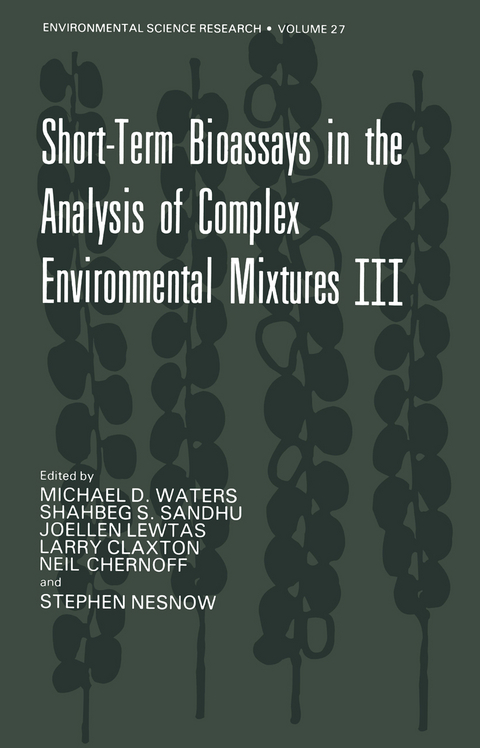
Short-Term Bioassays in the Analysis of Complex Environmental Mixtures III
Kluwer Academic/Plenum Publishers (Verlag)
978-0-306-41191-5 (ISBN)
- Titel z.Zt. nicht lieferbar
- Versandkostenfrei
- Auch auf Rechnung
- Artikel merken
Session 1: Collection And Preparation of Environmental Samples for Bioassays.- Some Aspects of Mutagenicity Testing of the Particulate Phase and the Gas Phase of Diluted and Undiluted Automobile Exhaust*.- Source Assessment Sampling System (SASS) Versus Dilution Tunnel Sampling*.- Preparation of Hazardous and Complex Samples for Ecological Testing*.- Sample Collection and Preparation Methods Affecting Mutagenicity and Cytotoxicity of Coal Fly Ash*.- The Use of Short-Term Bioassays to Monitor the Environmental Impact of Land Treatment of Hazardous Wastes*.- Mutagenicity Testing of Complex Mixtures Derived from Human Body Fluids*.- Evaluation by the Tradescantia Micronucleus test of the Mutagenicity of Internal Combustion Engine Exhaust Fumes from Diesel and Diesel-Soybean Oil Mixed Fuels+.- Session 2: Application of Bioassays to the Characterization of Hazardous Components.- Microbial Assays in Research and in the Characterization of Complex Mixtures*.- Fractionation of an Oil Shale Retort Process Water: Isolation of Photoactive Genotoxic Components*.- The Integration of Bioassay and Physiochemical Information for Complex Mixtures*.- Session 3: Development of Short-Term Bioassays: Mutagenicity and Cytotoxicity.- Isolation of Mutagens from Drinking Water: Something Old, Something New*.- Mutagenicity Testing of Complex Environmental Mixtures with Chinese Hamster Ovary Cells*.- Bioassays of Oil Shale Process Waters in Paramecium and Salmonella*.- A Search for the Identity of Genotoxic Agents in the Ambient Air Using the Tradescantia Bioassay*.- Relationship(s) Between Mutation and Cytotoxicity Induced InVitro*.- The Mouse Oocyte Toxicity Assay*.- Application of Bovine Macrophage Bioassays in the Analysis of Toxic Agents in Complex Environmental Mixtures*.- Determination ofDirect-Acting Mutagens and Clastogens in Oil Shale Retort Process Water*.- Unscheduled DNA Synthesis in Hamster Tracheal Epithelium Exposed InVitro to Chemical Carcinogens and Environmental Pollutants+.- InVitro Mutagenicity Testing of Ohio Coal-Derived Materials+.- Presence of Various Types of Mutagenic Impurities in Carbon Black Detected by the Salmonella Assay+.- Session 4: Development of Short-Term Bioassays: Carcinogenicity.- Criterion Development for the Application of BALB/c-3T3 Cells to Routine Testing for Chemical Carcinogenic Potential*.- A Quantitative, Clonal Assay for Carcinogen-Induced Alterations of Respiratory Epithelial Cells in Culture*.- Recent Experience with the Strain A Mouse Pulmonary Tumor Bioassay Model*.- Integrated Chemical and Biological Analysis of Asphalt and Pitch Fumes*.- Mouse Skin Carcinogenesis: Application to the Analysis of Complex Mixtures*.- Session 5: Development of Short-Term Bioassays: Teratology.- Frog Embryo Teratogenesis Assay: Xenoplus (FETAX) -- A Short-Term Assay Applicable to Complex Environmental Mixtures*.- Human Serum Teratogenicity Studies Using In Vitro Cultures of Rat Embryos*.- A Teratology Test System which Utilizes Postnatal Growth and Visibility in the Mouse*.- Session 6: Integrated Assessment.- Mutagenicity of Pulp and Paper Mill Effluent: A Comprehensive Study of Complex Mixtures*.- Evaluation in Man and Animals of Tests for the Detection of Population Exposures to Genotoxic Chemicals*.- Biological Activity of Air Particulate Extracts (APE) in Short-Term Tests*.- On the Use of Relative Toxicity for Risk Estimation*.- Passive Smoking and Urban Air Pollution: Salmonella/Microsome Mutagenicity Assay of Simultaneously Collected Indoor and Outdoor Particulate Matter*.- Environmental Aromatic Nitro Compounds and Their Bacterial Detoxification*.- Application of Mutagenicity Tests for Detection and Source Assessment of Genotoxic Agents in the Rubber Work Atmosphere*.- Mutagens in Airborne Particulate Pollutants and Nitro Derivatives Produced by Exposure of Aromatic Compounds to Gaseous Pollutants*.- *Invited paper.
| Reihe/Serie | Environmental Science Research ; 27 |
|---|---|
| Zusatzinfo | 589 p. |
| Sprache | englisch |
| Themenwelt | Studium ► 2. Studienabschnitt (Klinik) ► Pharmakologie / Toxikologie |
| Naturwissenschaften ► Physik / Astronomie ► Allgemeines / Lexika | |
| ISBN-10 | 0-306-41191-1 / 0306411911 |
| ISBN-13 | 978-0-306-41191-5 / 9780306411915 |
| Zustand | Neuware |
| Informationen gemäß Produktsicherheitsverordnung (GPSR) | |
| Haben Sie eine Frage zum Produkt? |
aus dem Bereich


